Masantol
San Miguel de Masantol | |
|---|---|
| Municipality of Masantol | |
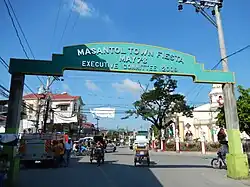 Downtown area | |
 Flag  Seal | |
| Etymology: Santol | |
| Motto: Kayabe Kabang Bie | |
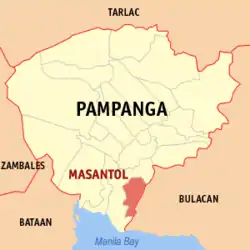 Map of Pampanga with Masantol highlighted | |
OpenStreetMap | |
.svg.png.webp) Masantol Location within the Philippines | |
| Coordinates: 14°54′N 120°43′E / 14.9°N 120.72°E | |
| Country | Philippines |
| Region | Central Luzon |
| Province | Pampanga |
| District | 4th district |
| Founded | 1878 |
| Reinstated | 1907 |
| Barangays | 26 (see Barangays) |
| Government | |
| • Type | Sangguniang Bayan |
| • Mayor | Jose Antonio C. Bustos III |
| • Vice Mayor | Danilo S. Guintu |
| • Representative | Anna York P. Bondoc-Sagum |
| • Municipal Council | Members |
| • Electorate | 40,000 voters (2022) |
| Area | |
| • Total | 48.25 km2 (18.63 sq mi) |
| Elevation | 5.0 m (16.4 ft) |
| Highest elevation | 35 m (115 ft) |
| Lowest elevation | −5 m (−16 ft) |
| Population (2020 census)[3] | |
| • Total | 57,990 |
| • Density | 1,200/km2 (3,100/sq mi) |
| • Households | 13,465 |
| Economy | |
| • Income class | 2nd municipal income class |
| • Poverty incidence | 10.24 |
| • Revenue | ₱ 181.3 million (2020) |
| • Assets | ₱ 159.5 million (2020) |
| • Expenditure | ₱ 194.2 million (2020) |
| • Liabilities | ₱ 46.76 million (2020) |
| Service provider | |
| • Electricity | Pampanga 3 Electric Cooperative (PELCO 3) |
| Time zone | UTC+8 (PST) |
| ZIP code | 2017 |
| PSGC | |
| IDD : area code | +63 (0)45 |
| Native languages | Kapampangan Tagalog |
| Website | www |
Masantol, officially the Municipality of Masantol (Kapampangan: Balen ning Masantol; Tagalog: Bayan ng Masantol), is a 2nd class municipality in the province of Pampanga, Philippines. According to the 2020 census, it has a population of 57,990 people.[3]
Etymology
The municipality is named after the santol trees that used to grow abundantly in the area.[5]
The reason is either because there was a proliferation of santol trees in the area, or because the town was where santol fruits were heavily bartered (Kapampangans being fond of 'sinigang' dish).
A legend of how the town got its name goes like this: 'A Spanish missionary came to the town for the first time. Upon reaching a roadside corner store, he parked his horse-driven vehicle and inquired from the store keeper the name of the place. A middle-aged woman vendor, believing that the Spanish priest was asking for the name of the fruits she was selling, readily responded in broken Spanish language, Padre, todos dulce Masantol. The priest took from his pocket a pencil and a small diary and wrote down the word mas santol, referring to the name of the place he has visited. At the time, the locality abounded with santol trees, and santol fruits were in season when the priest visited the place.
History
San Miguel de Masantol May 1, 1878
Originally named San Miguel de Masantol and a part of the town of Macabebe, three of the town's leading patriarchs - Manuel Fajardo, Gregorio Bautista, and Juan Lacap - filed a motion on June 26, 1877, to separate the barrios of Bebe, Bulacus, Caingin and Nigui from Macabebe thereby creating a new Spanish pueblo called San Miguel. This new pueblo was approved by Spanish Governor General Domingo Moriones y Murillo and was inaugurated on May 1, 1878. On November 30, 1893, the Catholic Parish of San Miguel was formally acknowledged through a Royal Decree.[6] For a while it came to be known San Miguel Masantol, until popular usage reverted it to the original name.
Balen ning Masantol 1907
On July 26, 1904, Masantol once more became part of Macabebe. However, in 1907, Masantol was again reinstated as a separate independent municipality and this lasted up to the present.[6]
The Battle of Bangkusay Channel The Ruler of Macabebe
Tarik Sulayman Bambalino / Bankau or for some Historians the Unnamed ruler of Macabebe was the indigenous leader of Macabebe from the "Masantol area", who refused to ally with the Spaniards and therefore mounted an attack against the Spanish forces of Miguel López de Legazpi during the Battle of Bangkusay Channel on June 3, 1571. The Joint Force of Macabebe, Calumpit, Hagonoy and Maynila "Old Rajahnate of Maynila under Rajah Sulayman III / Rajah Mura/Muda of Manila" were defeated, by the Joint Force of Spanish Armada and Tagalog mercenaries and Tarik Sulayman himself was killed in the Battle, and Consequently, this victory enabled the Spaniards to establish themselves throughout the city "Territory of Kingdom of Tondo" and its neighboring Kingdoms and towns.
Tragedy
On January 7, 2008, one person drowned, another missing and 40 others were injured due to electric shocks, when a live cable hit the floating pagoda boat in the fluvial festival of Virgen La Purisima Concepcion at Barangay Alauli.[7]
Geography
Masantol is almost surrounded by the municipality of Macabebe (For it was once a former part of the town). It is known to be the southernmost town in the province of Pampanga. It is bounded to the north by the municipality of Macabebe; to the east by the municipalities of Calumpit and Hagonoy in Bulacan; to the west by Macabebe; and to the south by some parts of Macabebe and Manila Bay.
Climate
| Climate data for Masantol, Pampanga | |||||||||||||
|---|---|---|---|---|---|---|---|---|---|---|---|---|---|
| Month | Jan | Feb | Mar | Apr | May | Jun | Jul | Aug | Sep | Oct | Nov | Dec | Year |
| Mean daily maximum °C (°F) | 28 (82) |
29 (84) |
31 (88) |
33 (91) |
32 (90) |
31 (88) |
30 (86) |
29 (84) |
29 (84) |
30 (86) |
30 (86) |
28 (82) |
30 (86) |
| Mean daily minimum °C (°F) | 20 (68) |
20 (68) |
21 (70) |
23 (73) |
24 (75) |
24 (75) |
24 (75) |
24 (75) |
24 (75) |
23 (73) |
22 (72) |
21 (70) |
23 (72) |
| Average precipitation mm (inches) | 6 (0.2) |
4 (0.2) |
6 (0.2) |
17 (0.7) |
82 (3.2) |
122 (4.8) |
151 (5.9) |
123 (4.8) |
124 (4.9) |
99 (3.9) |
37 (1.5) |
21 (0.8) |
792 (31.1) |
| Average rainy days | 3.3 | 2.5 | 3.6 | 6.6 | 17.7 | 22.2 | 25.2 | 23.7 | 23.2 | 17.9 | 9.2 | 5.2 | 160.3 |
| Source: Meteoblue[8] | |||||||||||||
Barangays
Masantol is politically subdivided into 26 barangays. Each barangay consists of puroks and some have sitios.
- Alauli
- Bagang
- Balibago
- Bebe Anac
- Bebe Matua
- Bulacus
- San Agustin (Caingin)
- Santa Monica (Caingin)
- Cambasi
- Malauli
- Nigui
- Palimpe
- Puti
- Sagrada (Tibagin)
- San Isidro Anac
- San Isidro Matua (Poblacion)
- San Nicolas (Poblacion)
- San Pedro
- Santa Cruz
- Santa Lucia Matua
- Santa Lucia Paguiaba
- Santa Lucia Wakas
- Santa Lucia Anac (Poblacion)
- Sapang Kawayan
- Sua
- Santo Niño
Sitios
- Bebe Arabia
- Sagrada 2
Demographics
|
| |||||||||||||||||||||||||||||||||||||||||||||||||||
| Source: Philippine Statistics Authority[9][10][11][12] | ||||||||||||||||||||||||||||||||||||||||||||||||||||
In the 2020 census, the population of Masantol, Pampanga, was 57,990 people,[3] with a density of 1,200 inhabitants per square kilometre or 3,100 inhabitants per square mile.
Religion
The majority of the population are members of the Catholic church and each village or barangay has its own fiesta. The main Roman Catholic parish church of the town is the San Miguel Parish Church in Barangay San Nicolas, established in the late 20th century.
- 80% One Holy Apostolic Catholic Church (Christian) (Roman rite)
- 15% Evangelical, Pentecostal, Presbyterian, Jesus Is Lord Church, Protestant etc. (Christian Denomination)
- 1% Iglesia Ni Cristo
- 0.20% Islam (Sunni, Shia)
- 0.10% others/non-believers/atheist
Economy
Festivals
- Batalla San Miguel Arkangel (Apung Igue) - May 8, All Masantolenos
- Battalla Santo Niño - every last Sunday of January. - Barangay Santo Nino
- Batalla Santa Monica - May 4. - Barangay Santa Monica Caingin
- Batalla San Roque de Montpelier (Apung Duque) - August 15,16,17 Sitio Bebe Arabia, Barangay Bebe Anac
- Batalla San Roque (Apung Duque) - 3rd or 4th Sunday of April - Sitio Bebe Arabia, Barangay Bebe Anac, Barangay Bebe Matua
- Batalla San Roque de Montpelier (Apung Duque) - August 15,16,17 Barangay Bebe Matua
- Fiesta de San Nicolas (Apung Culas) - May 12 and September 10 - Barangay San Nicolas
- Feast of The HOLY ROSARY - every 2nd Saturday of October in BULACUS MASANTOL
- Batalla de Santa Lucia (Apung Lucia) - December 13 of the year. - Barangay Santa Lucia Wakas, Matua, Anac
- Batalla de San Agustin (Apung Gustin)- August 28 Barangay San Agustin Caingin
- Limbun at Libad or Labas Larawan (Celebration of the Saints) in each barrio/barangay celebrating their patron saint for ones a week in January.
Education
Masantol is home to several primary, secondary, Vocational and Collage School among them are:
- Pampanga institute (Collage)
- TESDA Vocational Training Center (Under the Municipality support)
- San Miguel Academy Semi-Catholic School (Christian School) (Junior/Siñor High School)
- Holy Child of Mary Academy Semi-Catholic School (Christian School) (Junior/Siñor High School)
- Pampanga Institute (Junior/Siñor High School) 1st high school institution in town of Masantol
- Masantol Central High School (Siñor High)
- Masantol National High School (Junior High) (fmr. Santa Lucia High School)
- Masantol High School Annex (Junior High) (Tarik Suliman High School)
- Masantol High School Annex (Junior High) (Malauli High School)
- St. Michael The Archangel Archdiocesan Parochial School Exclusive Catholic School (Masantol Parochial School)
- Masantol Elementary School (Masantol Central Elementary School)
- Bagang Elem. School
- Caingin Elem. School
- Palimpe Elem. School
- Bebe Anac Elem. School
- Bebe Matua Elem School
- Puti Elem. School
- Sagrada Elem. School
- Sua Elem. School
- San Isidro Elem. School
- Balibago Elem. School
- SantaLucia elem school
- Alauli Elem School
- San Pedro Elem School
- Santa Cruz Main Elem School
- Santa Cruz (Annex) Elem School
- San Nicolas Elem School
- Bagang Elem School
- Balibago Elem School
- Nigui Elem School
Gallery
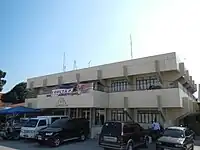 Town hall
Town hall Covered court and 1878 Masantol Monument
Covered court and 1878 Masantol Monument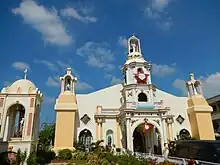 St. Michael the Archangel Parish Church
St. Michael the Archangel Parish Church Public Market
Public Market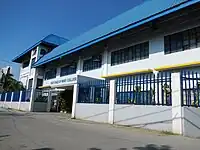 Holy Child of Mary College
Holy Child of Mary College
References
- ↑ Municipality of Masantol | (DILG)
- ↑ "2015 Census of Population, Report No. 3 – Population, Land Area, and Population Density" (PDF). Philippine Statistics Authority. Quezon City, Philippines. August 2016. ISSN 0117-1453. Archived (PDF) from the original on May 25, 2021. Retrieved July 16, 2021.
- 1 2 3 Census of Population (2020). "Region III (Central Luzon)". Total Population by Province, City, Municipality and Barangay. Philippine Statistics Authority. Retrieved 8 July 2021.
- ↑ "PSA Releases the 2018 Municipal and City Level Poverty Estimates". Philippine Statistics Authority. 15 December 2021. Retrieved 22 January 2022.
- ↑ Alejandro S. Camiling. "The Town of Masantol, Pampanga". Historical articles. andropampanga.com. Retrieved 13 December 2012.
- 1 2 "The Town of Masantol, Pampanga". Andropampanga. 2009. Retrieved 2009-08-05.
{{cite web}}: External link in|publisher= - ↑ chinapost.com.tw, One drowns, 40 injured in Philippine boat mishap
- ↑ "Masantol: Average Temperatures and Rainfall". Meteoblue. Retrieved 5 May 2020.
- ↑ Census of Population (2015). "Region III (Central Luzon)". Total Population by Province, City, Municipality and Barangay. Philippine Statistics Authority. Retrieved 20 June 2016.
- ↑ Census of Population and Housing (2010). "Region III (Central Luzon)" (PDF). Total Population by Province, City, Municipality and Barangay. National Statistics Office. Retrieved 29 June 2016.
- ↑ Censuses of Population (1903–2007). "Region III (Central Luzon)". Table 1. Population Enumerated in Various Censuses by Province/Highly Urbanized City: 1903 to 2007. National Statistics Office.
{{cite encyclopedia}}: CS1 maint: numeric names: authors list (link) - ↑ "Province of Pampanga". Municipality Population Data. Local Water Utilities Administration Research Division. Retrieved 17 December 2016.
- ↑ "Poverty incidence (PI):". Philippine Statistics Authority. Retrieved December 28, 2020.
- ↑ "Estimation of Local Poverty in the Philippines" (PDF). Philippine Statistics Authority. 29 November 2005.
- ↑ "2003 City and Municipal Level Poverty Estimates" (PDF). Philippine Statistics Authority. 23 March 2009.
- ↑ "City and Municipal Level Poverty Estimates; 2006 and 2009" (PDF). Philippine Statistics Authority. 3 August 2012.
- ↑ "2012 Municipal and City Level Poverty Estimates" (PDF). Philippine Statistics Authority. 31 May 2016.
- ↑ "Municipal and City Level Small Area Poverty Estimates; 2009, 2012 and 2015". Philippine Statistics Authority. 10 July 2019.
- ↑ "PSA Releases the 2018 Municipal and City Level Poverty Estimates". Philippine Statistics Authority. 15 December 2021. Retrieved 22 January 2022.
